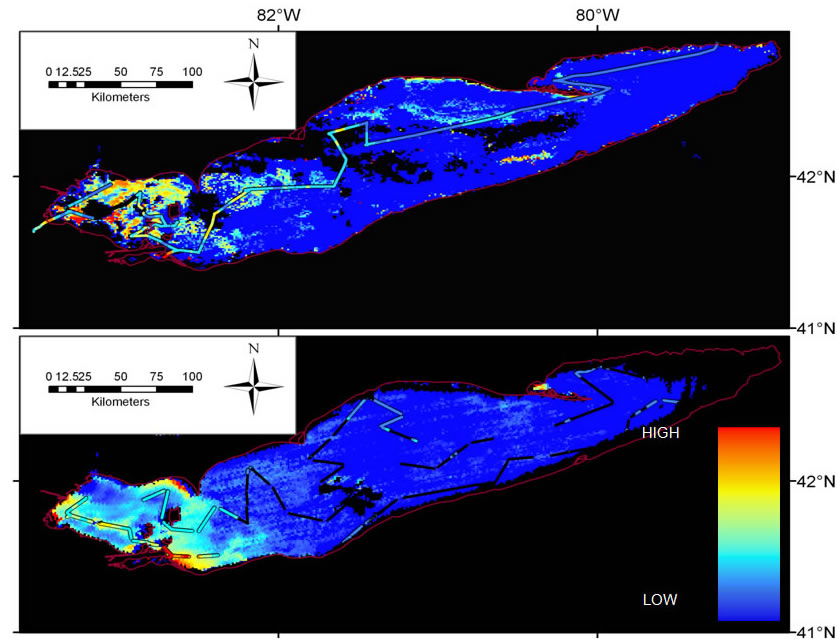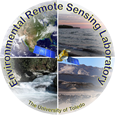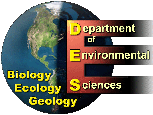Algal Blooms
Over the past 15 years, I have been developing expertise in and research capabilities in the area of aquatic remote sensing, specifically in limnologic (inland or fresh water) and coastal remote sensing. Our main area of interest is the Great Lakes.
Encompassing nearly twenty percent of the world’s freshwater supply, the Great Lakes have long served multiple societal needs. Algal blooms have reappeared in the Great Lakes with greater frequency and intensity in recent years. Moreover, the possibility of toxin producing strains can lead to significant water management issues.
Currently, we are working as part of a multi-institutional effort to utilize airborne hyperspectral measurements to improve algae identification. As a part of this, ESRL is flying a custom UAV with an integrated VIR/NIR spectrometer to map bloom variation deployed either from shore or a vessel.
In the past, we obtained funding for a suite of instruments to be deployed in the western basin, including new YSI fluorometers, eddy flux tower micrometeorolgy components and an absorption spectrometer to complement the measurements already taken to study the components of water and carbon flux in Lake Erie.
Previously As part of the MERHAB (Monitoring and Event Response for Harmful Algal Blooms) project, I explored the utility of chlorophyll extraction techniques to map the spatial and temporal variations in algal blooms in Lake Erie and Lake Ontario.
Remote sensing is coupled with in-situ measurements of algal concentrations (chlorophyll-a) in Lakes Erie and Ontario, and the images also are used with predictions from a hydrodynamic and particle tracking model to determine transport pathways. The project goal is to develop a system that uses remote sensing to identify the formation of a bloom and can predict the movement of the bloom through modeling.
I have tested a variety of the existing models to produce Chlorophyll products for the lower great lakes. Preliminary results show that Carder's Algorithm (Carder, 1999), deployed in SeaDAS provides the most reliable numeric values for Lake Erie and Lake Ontario.
In addition, I have developed an algorithm to determine the abundance of Phycocyanin in Lake Erie and Lake Ontario, to help delineate potentially harmful algal blooms.
s.

Related Publications:
Lekki, J , Anderson, R., Avouris, D., Becker, R.H., Cline, M.T., Leshkevich, G., Liou, L., Luvall, J.C., Ortiz, J.D., Ruberg, S.A., Sawtell, R., Sayers, M., Schiller, S., Shuchman, R.A., Simic, A., Stuart, D.G., Tokars, R., and Vander Woude, A.J., 2017, Airborne Hyperspectral Sensing of Monitoring Harmful Algal Blooms in the Great Lakes Region: System Calibration and Validation, NASA Technical Memorandum NASA/TM—2017-219071Ouyang*, Z., Shao. C., Chu, H., Becker, R., Bridgeman, T., Stepien, C., John, R., Chen., J., The Effect of Algal Blooms on Carbon Emissions in Western Lake Erie: An Integration of Remote Sensing and Eddy Covariance Measurements, 2017, Remote Sensing, 9(1), 44; doi:10.3390/rs9010044
Shao, C., Chen, J., Stepien, C.A., Chu, H.*, Bridgeman, T., Czajkowski, K., Becker, R.H., Ouyang, Z.*, John, R., 2015, Diurnal to annual carbon, latent and sensible heat fluxes in a Laurentian Great Lake: A case study in western Lake Erie, JGR Biogeosciences, doi:10.1002/2015JG003025Becker, R.H., Sultan, M.I., Boyer, G.L., Twiss, M.R., and Konopko, E., 2009, Mapping Cyanobacterial Blooms in the Great Lakes Using MODIS, Journal of Great Lakes Research, doi:10.1016/j.jglr.2009.05.007
Selected Presentations:
Traub, J.*, Becker, R.H., 2012, Assessing spatio-temporal variation in CDOM absorption in the Western Basin of Lake Erie, ASPRS Annual Conference, Pasadena, CA
Nagel, C.**, Becker, R.H., 2012, Measuring Sediment Concentrations in the Maumee River with Satellite Images, ASPRS Annual Conference, Pasadena, CA
Becker, R., Sultan, M., Boyer, G.L., Twiss, M.R.,
Using MODIS to Map Cyanobacteria in Lake Erie, IAGLR 2009, May 18-22,
2009, Toledo, OH
Becker, R., Sultan, M., Boyer, G.L., Twiss, M.R., Konopko, E., 2007, Mapping Cyanobacterial Blooms in The Lower Great Lakes From MODIS and SeaWiFS Data, International Association of Great Lakes Research (IAGLR) 50th Annual Meeting.
Becker, R., Sultan, M., Boyer, G.L., Twiss, M.R., Konopko, E., 2007, Mapping Cyanobacterial Blooms in The Lower Great Lakes From MODIS and SeaWiFS Data, ASLO Aquatic Sciences Meeting
Becker, R., Sultan, M., Boyer, G., Atkinson, J., Konopko, E., 2005, Temporal and Spatial Distribution of Algal Blooms in the Lower Great Lakes, Eos Trans. AGU, 86(52), Fall Meet. Suppl., Abstract OS31A-1436
Links to MERHAB LGL groups:
Greg Boyer, SUNY - College of Environmental Science and Forestry
Joseph Atkinson, SUNY- University at Buffalo
Joseph Makarewicz, SUNY Brockport
Mary Watzin, University of Vermont
Steve Wilhelm, University of Tennessee
Funded by: NOAA


